It looks like you're using an Ad Blocker.
Please white-list or disable AboveTopSecret.com in your ad-blocking tool.
Thank you.
Some features of ATS will be disabled while you continue to use an ad-blocker.
share:
I may be wrong, but that was my understanding of what I read about the experiment, although I said that the second results were negative while they
weren't, they were different.
Each soil sample was tested more than once, with the first injection of (supposed) nutrients giving the more known results. A second or third injection didn't give the same results, and there were differences between samples.
To make things clearer and help the discussion here are the charts showing the results of the tests.
Viking 1, cycle 1.
Sample Site: Sandy Flats Site
Collection Time: Sol 8 07:05 LLT
Experiment Type: Active
Comment:
First Injection: Sol 10 05:36 LLT
Second Injection: Sol 17 05:38 LLT
Purge: Sol 23 12:12 LLT
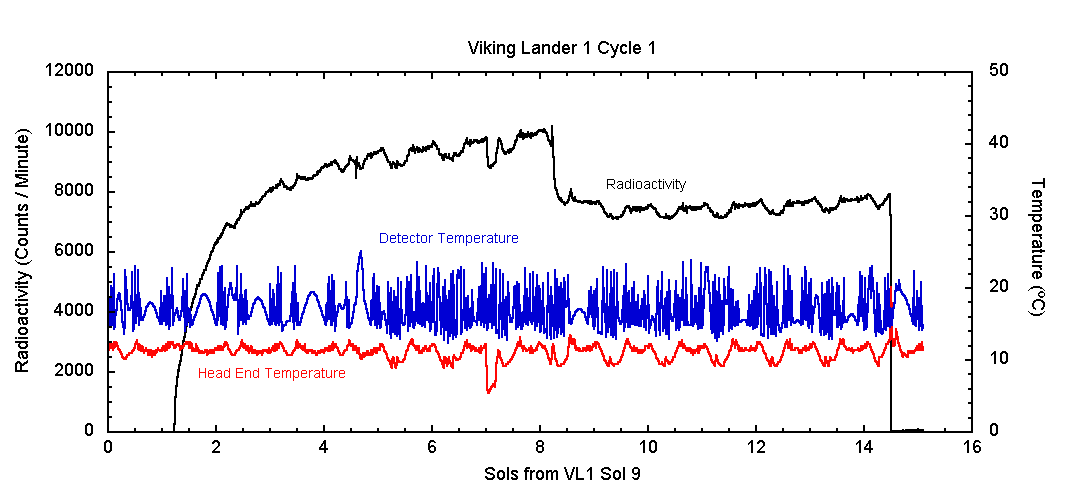
Viking 1, cycle 2.
Sample Site: Sandy Flats Site
Collection Time: Sol 8 07:05 LLT
Experiment Type: 160° control
Comment: Used sample stored in Biology hopper for 20 sols
First Injection: Sol 29 05:59 LLT
Second Injection: Sol 35 05:38 LLT
Purge: Sol 37 13:23 LLT
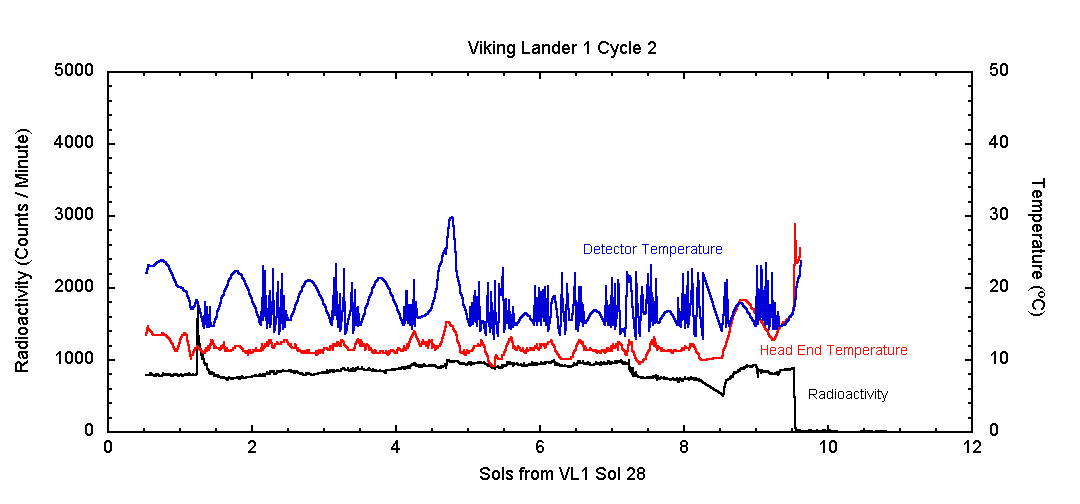
Viking 1, cycle 3.
Sample Site: Sandy Flats Site
Collection Time: Sol 36 11:21 LLT
Experiment Type: Active
Comment: Long incubation with three injections
First Injection: Sol 39 05:59 LLT
Second Injection: Sol 55 05:11 LLT
Third Injection: Sol 80 05:08 LLT
Purge: Sol 89 12:20 LLT
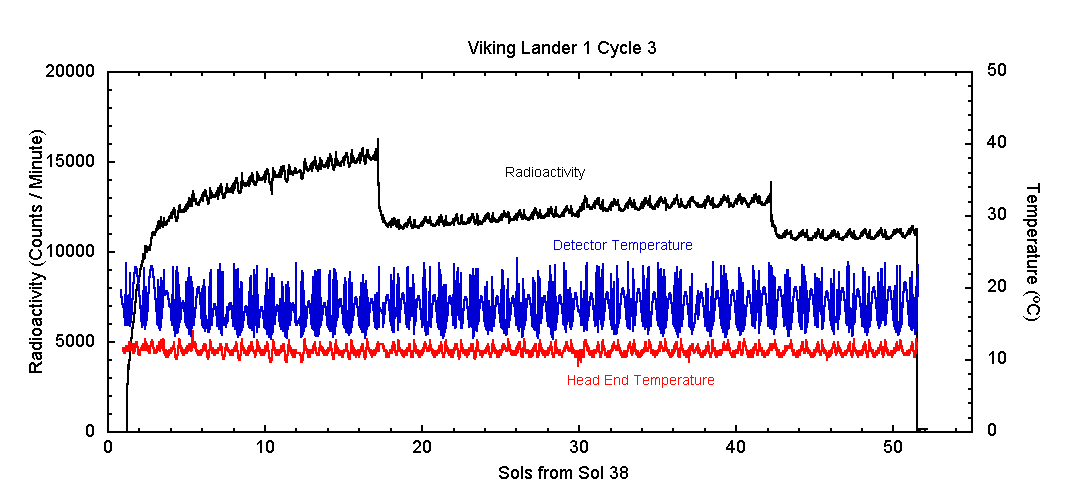
Viking 1, cycle 4.
Sample Site: Sandy Flats Site
Collection Time: Sol 91 07:11 LLT
Experiment Type: Active
Comment: Sample stored in Biology hopper for about 140 sols
First Injection: UNK LLT
Second Injection: UNK LLT
Purge: No purge
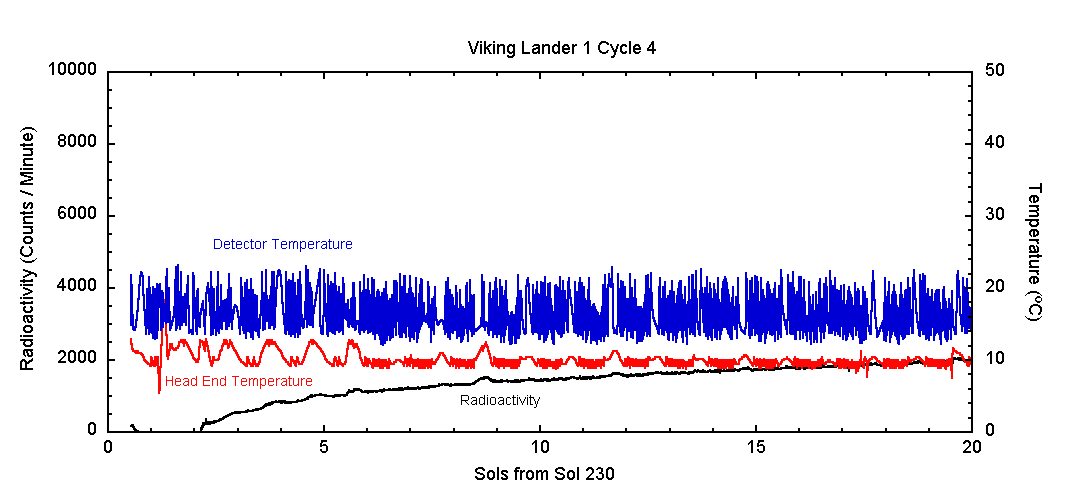
Viking 2, cycle 1.
Sample Site: Beta Site
Collection Time: Sol 8 16:10 LLT
Experiment Type: Active
Comment:
First Injection: Sol 11 05:45 LLT
Second Injection: Sol 18 05:47 LLT
Purge: Sol 24 16:36 LLT

Viking 2, cycle 2.
Sample Site: Beta Site
Collection Time: Sol 28 16:13 LLT
Experiment Type: 50° C Control
Comment: Cold sterilization
First Injection: Sol 34 06:51 LLT
Second Injection: Sol 38 05:47 LLT
Purge: UNK LLT
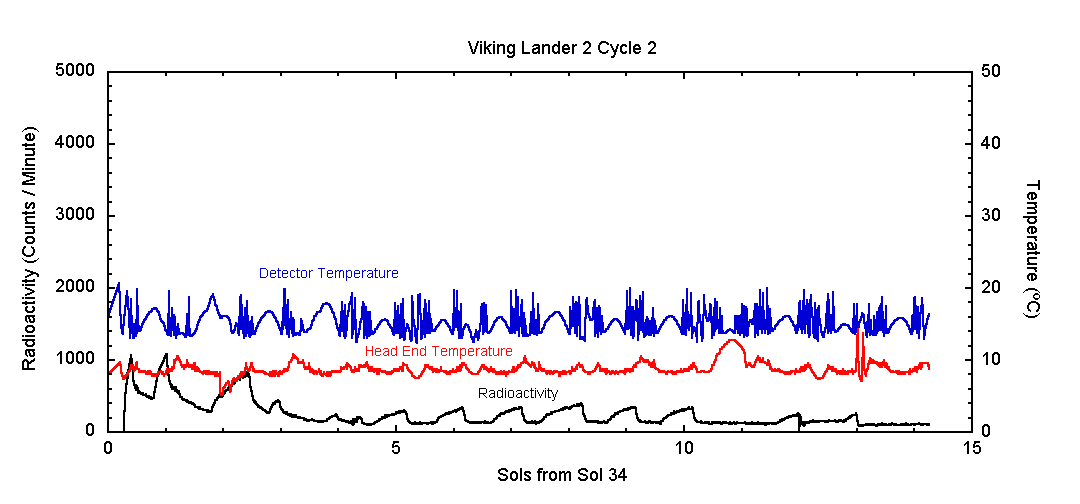
Viking 2, cycle 3.
Sample Site: Notch Rock
Collection Time: Sol 51 06:56 LLT
Experiment Type: Active
Comment: Sample obtained from under Notch Rock; Long incubation
First Injection: Sol 53 05:45 LLT
Second Injection: Sol 60 04:58 LLT
Purge: Sol 140 00:14 LLT
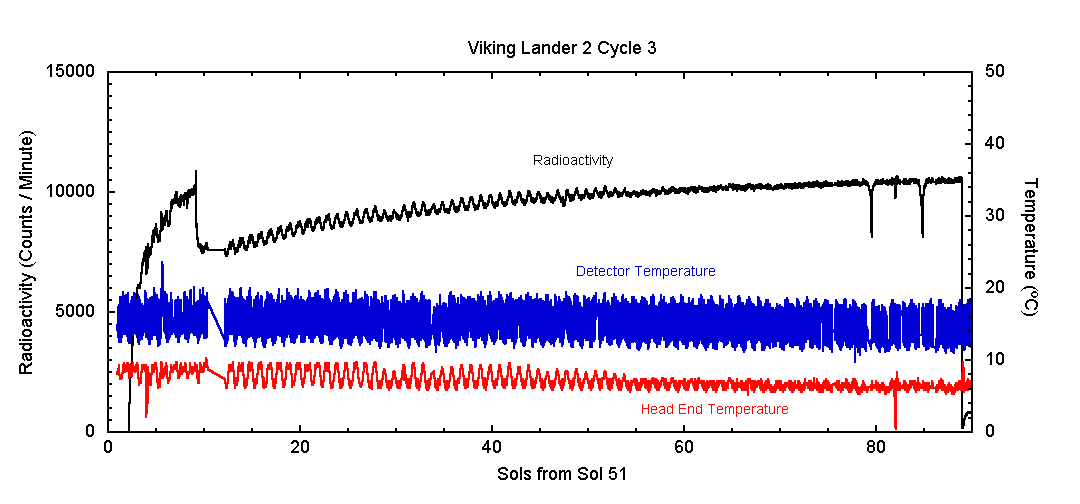
Viking 2, cycle 4.
Sample Site: Beta Site
Collection Time: Sol 145 09:10 LLT
Experiment Type: 46° C Control
Comment: Cold sterilization
First Injection: Sol 147 05:52 LLT
Second Injection: Sol 161 05:30 LLT
Purge: Sol 170 23:34 LLT
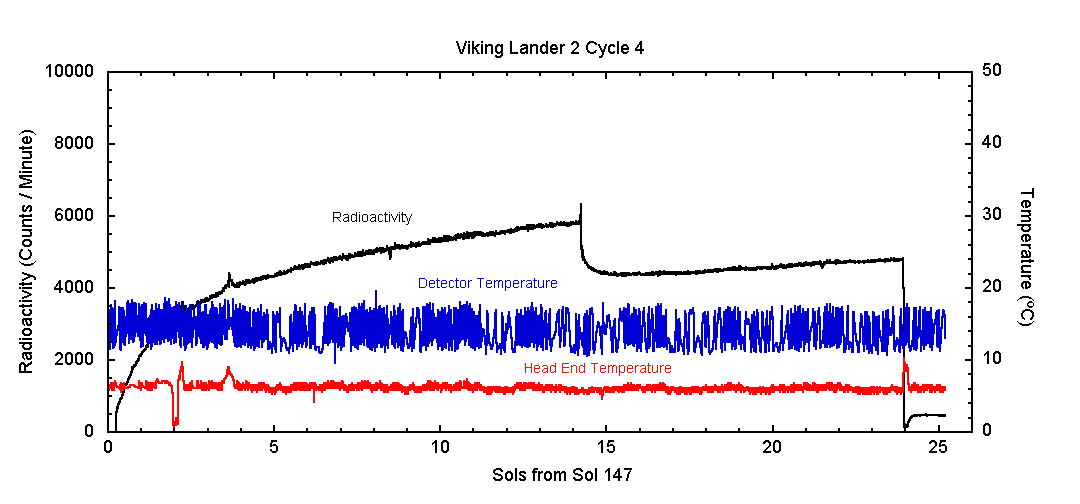
Viking 2, cycle 5.
Sample Site: Beta Site
Collection Time: Sol 145 09:10 LLT
Experiment Type: Active
Comment: Sample stored in Biology hopper; Analysis done in used test chamber
First Injection: Sol 229 05:43 LLT
Purge: No Purge
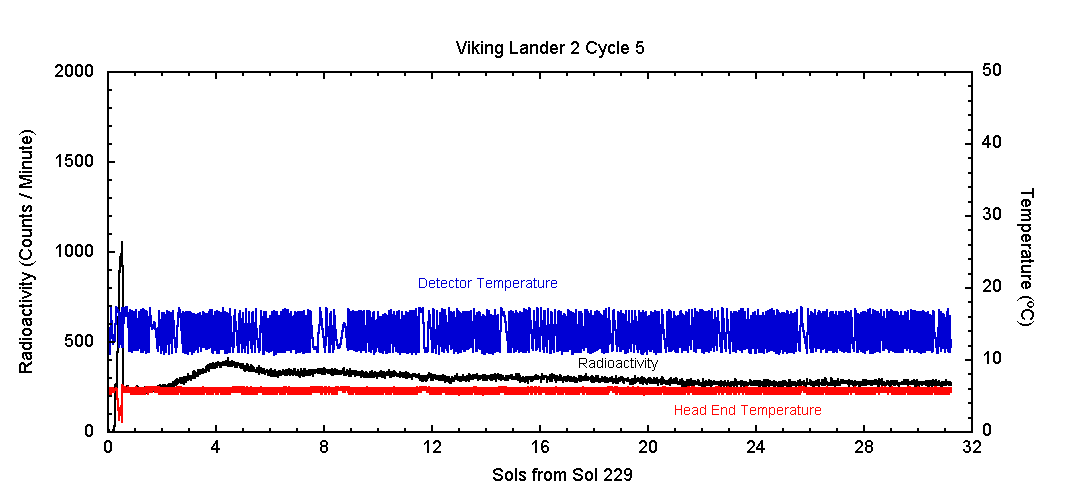
Edited to add where I got the above data from, this page.
Each soil sample was tested more than once, with the first injection of (supposed) nutrients giving the more known results. A second or third injection didn't give the same results, and there were differences between samples.
To make things clearer and help the discussion here are the charts showing the results of the tests.

Viking 1, cycle 1.
Sample Site: Sandy Flats Site
Collection Time: Sol 8 07:05 LLT
Experiment Type: Active
Comment:
First Injection: Sol 10 05:36 LLT
Second Injection: Sol 17 05:38 LLT
Purge: Sol 23 12:12 LLT

Viking 1, cycle 2.
Sample Site: Sandy Flats Site
Collection Time: Sol 8 07:05 LLT
Experiment Type: 160° control
Comment: Used sample stored in Biology hopper for 20 sols
First Injection: Sol 29 05:59 LLT
Second Injection: Sol 35 05:38 LLT
Purge: Sol 37 13:23 LLT

Viking 1, cycle 3.
Sample Site: Sandy Flats Site
Collection Time: Sol 36 11:21 LLT
Experiment Type: Active
Comment: Long incubation with three injections
First Injection: Sol 39 05:59 LLT
Second Injection: Sol 55 05:11 LLT
Third Injection: Sol 80 05:08 LLT
Purge: Sol 89 12:20 LLT

Viking 1, cycle 4.
Sample Site: Sandy Flats Site
Collection Time: Sol 91 07:11 LLT
Experiment Type: Active
Comment: Sample stored in Biology hopper for about 140 sols
First Injection: UNK LLT
Second Injection: UNK LLT
Purge: No purge

Viking 2, cycle 1.
Sample Site: Beta Site
Collection Time: Sol 8 16:10 LLT
Experiment Type: Active
Comment:
First Injection: Sol 11 05:45 LLT
Second Injection: Sol 18 05:47 LLT
Purge: Sol 24 16:36 LLT

Viking 2, cycle 2.
Sample Site: Beta Site
Collection Time: Sol 28 16:13 LLT
Experiment Type: 50° C Control
Comment: Cold sterilization
First Injection: Sol 34 06:51 LLT
Second Injection: Sol 38 05:47 LLT
Purge: UNK LLT

Viking 2, cycle 3.
Sample Site: Notch Rock
Collection Time: Sol 51 06:56 LLT
Experiment Type: Active
Comment: Sample obtained from under Notch Rock; Long incubation
First Injection: Sol 53 05:45 LLT
Second Injection: Sol 60 04:58 LLT
Purge: Sol 140 00:14 LLT

Viking 2, cycle 4.
Sample Site: Beta Site
Collection Time: Sol 145 09:10 LLT
Experiment Type: 46° C Control
Comment: Cold sterilization
First Injection: Sol 147 05:52 LLT
Second Injection: Sol 161 05:30 LLT
Purge: Sol 170 23:34 LLT

Viking 2, cycle 5.
Sample Site: Beta Site
Collection Time: Sol 145 09:10 LLT
Experiment Type: Active
Comment: Sample stored in Biology hopper; Analysis done in used test chamber
First Injection: Sol 229 05:43 LLT
Purge: No Purge

Edited to add where I got the above data from, this page.

edit on 7/1/2017 by ArMaP because: (no reason given)
One of the KEY instruments of science, that can virtually prove that microbial life would exist on Mars, is the SEM (Scanning Electronic Microscope).
Why this instrument was never included on any Mars probe, is really puzzling, as it really removes any ambiguity from chemical tests that look for
trace gases that would show life. Take a look at this SEM, from a recent meteorite that fell in Sri Lanka..

Even if this particular fossil turned out to be contamination on Earth, having the SEM on the Mars probe, and capturing an image like this would be definitive proof. Why has this intrument been left of the science packages?

Microbial fossils in Meteorites
Professor Wickramasinghe, 74, claims microbes from outer space arrived on our planet from comets which then 'multiplied and seeded' to form our life. This SEM image from a two-inch wide piece of meteorite that was found near a village a few miles from the city of Polonnaruwa in Sri Lanka.
Even if this particular fossil turned out to be contamination on Earth, having the SEM on the Mars probe, and capturing an image like this would be definitive proof. Why has this intrument been left of the science packages?
originally posted by: charlyv
One of the KEY instruments of science, that can virtually prove that microbial life would exist on Mars, is the SEM (Scanning Electronic Microscope). Why this instrument was never included on any Mars probe, is really puzzling, as it really removes any ambiguity from chemical tests that look for trace gases that would show life.
I suppose one of the reasons is that SEMs that can work with unprepared targets are relatively new, and SEMs for the specific conditions of Mars have never been made, but it looks like NASA has thought about that.
What would YOU study if you had a SEM on Mars?
Miniaturized Environmental Scanning Electron Microscope for In Situ Planetary Studies
originally posted by: ArMaP
I may be wrong, but that was my understanding of what I read about the experiment, although I said that the second results were negative while they weren't, they were different (...)
Edited to add where I got the above data from, this page.
Thanks for the diagrams and the link to the PDS archive. And below you'll find some information that may help interpreting the data. That was before MSL detected perchlorates, but it's interesting nonetheless:
Joseph Miller
a reply to: jeep3r
Levin is an old senile has been. And--unfortunately for ATS--none of hte claims of life on mars have survived scrutiny. There's no ground to suggest a conspiracy. NASA is earnest looking for evideicne but with a high degree of scientific assurance. And that means hard, very hard work, very unlike the knee jerk sensationalist imaginary realm of hte conspiracy theorist.
A promising future mission is the Mars 2020 program. A rover is bent sent to a ancient seabed--as I understand--and there's hope they might discover evidence of past life. If Mars has ever had life, looking for past life is about as good we can do, since finding present life could be very difficult, given conditions are so hostile and those locations where present life might exist are restricted for contamination concerns. Moreso, learning about the history is important because it could also give us a hint where Martian life may exist today.
mars.nasa.gov - Mars 2020 Rover...
Levin is an old senile has been. And--unfortunately for ATS--none of hte claims of life on mars have survived scrutiny. There's no ground to suggest a conspiracy. NASA is earnest looking for evideicne but with a high degree of scientific assurance. And that means hard, very hard work, very unlike the knee jerk sensationalist imaginary realm of hte conspiracy theorist.
A promising future mission is the Mars 2020 program. A rover is bent sent to a ancient seabed--as I understand--and there's hope they might discover evidence of past life. If Mars has ever had life, looking for past life is about as good we can do, since finding present life could be very difficult, given conditions are so hostile and those locations where present life might exist are restricted for contamination concerns. Moreso, learning about the history is important because it could also give us a hint where Martian life may exist today.
mars.nasa.gov - Mars 2020 Rover...
edit on 1/7/2017 by jonnywhite because: (no reason given)
a reply to: ArMaP
I would consider them a necessity if the true overall mission is to determine if there is life on Mars. I would also think that the safety of those that would be on a Mars mission, would be paramount as well. Who knows what could turn up in a SEM image, and provide precautionary knowledge beforehand.
I would consider them a necessity if the true overall mission is to determine if there is life on Mars. I would also think that the safety of those that would be on a Mars mission, would be paramount as well. Who knows what could turn up in a SEM image, and provide precautionary knowledge beforehand.
a reply to: jonnywhite
To each his own I guess.
I guess because he's old and senile...nobody wants to debate him in an open academic debate.
Levin is an old senile has been. And--unfortunately for ATS--none of hte claims of life on mars have survived scrutiny. There's no ground to suggest a conspiracy. NASA is earnest looking for evideicne but with a high degree of scientific assurance. And that means hard, very hard work, very unlike the knee jerk sensationalist imaginary realm of hte conspiracy theoris
To each his own I guess.
I guess because he's old and senile...nobody wants to debate him in an open academic debate.
originally posted by: jonnywhite
Levin is an old senile has been.
He wasn't an old senile has been when he wrote his first report about the experiment, but I do think that he has spent too much time in trying to prove that his first opinion was right and those against it were wrong.
In my opinion that made him a kind of persona non grata and may have prevented him from participating in other missions (my speculation).
originally posted by: redoubt
a reply to: jeep3r
I have seen so many photos that the media has focused upon and then, so many so completely ignored.
This was called a 'rock'.
Right.
It looks like the fine details in the above image have been smoothed through excessive zooming and the colors/contrast have been enhanced. A look at the original image (small) compared to a zoom without smoothing shows that the details are in fact not so pronounced:
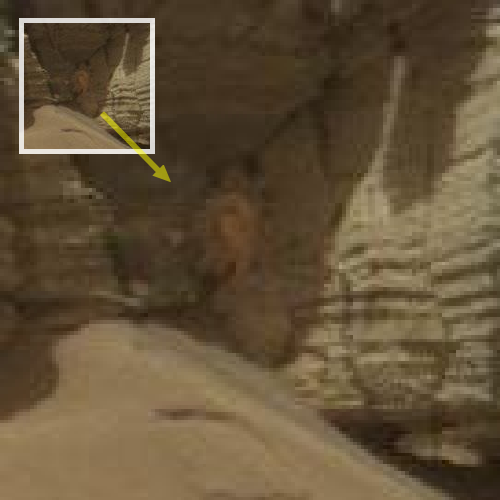
Instead, we can see the typical jpeg compression artifacts. So unless we get a closer camera view of this section (which I think doesn't exist), it seems we cannot say much about this feature.
Source: Sol 710
Source: Analyst's Notebook
edit on
8-1-2017 by jeep3r because: text
a reply to: jeep3r
Okee dokee... let's do it this way:
Here's the original -
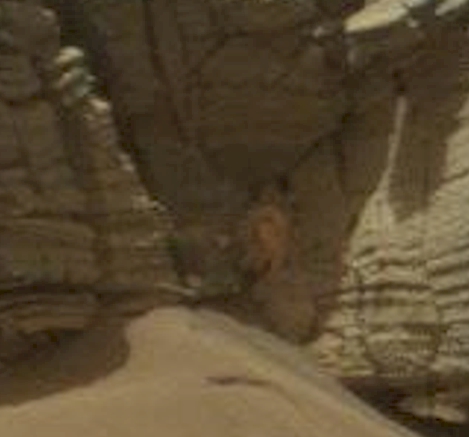
---------------------------------------------
Here, again, is the improved -

Now then, please take your time and point out any distinct differences between the two images, besides one being sharper and one blurrier.
Okee dokee... let's do it this way:
Here's the original -

---------------------------------------------
Here, again, is the improved -

Now then, please take your time and point out any distinct differences between the two images, besides one being sharper and one blurrier.
If you zoom into a Botti far enough you can see the water under the vault but was that intended?
originally posted by: redoubt
a reply to: jeep3r
Okee dokee... let's do it this way:
Now then, please take your time and point out any distinct differences between the two images, besides one being sharper and one blurrier.
Then let's have a look at the two right next to each other:
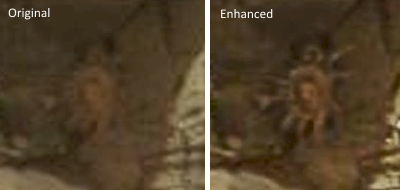
Can you spot the difference? In the enhanced version, the lines seem to be connected to the central piece, whereas in the original version this is much less pronounced and it may well be separate smaller rocks and features which are unrelated to the piece in the center.
I'm not saying it wouldn't have been worth a closer look. But the enhancement exaggerates certain details, thus blurring the lines (literally speaking).
a reply to: jeep3r
If this had been taken on Earth...
... nah.
Nevermind.
Have a nice day
In the enhanced version, the lines seem to be connected to the central piece, whereas in the original version this is much less pronounced and it may well be separate smaller rocks and features which are unrelated to the piece in the center.
If this had been taken on Earth...
... nah.
Nevermind.
Have a nice day
Revealing life on Mars would be a world changing event that would bring us all together. I wish they would tell us what is really out there.
a reply to: LostonEarth
I wish that was true, but I fear that people on Earth would say, "OK, there are germs on Mars," and then carry on killing each other regardless.
I wish that was true, but I fear that people on Earth would say, "OK, there are germs on Mars," and then carry on killing each other regardless.
a reply to: jeep3r
So interesting that as soon as i join up this is the first thread that is on the recent posts page.
Our solar System is teaming with intelligent life I know this for a fact.
They just want to cover it up, once i reach my 20 posts i will write more on this subject
So interesting that as soon as i join up this is the first thread that is on the recent posts page.
Our solar System is teaming with intelligent life I know this for a fact.
They just want to cover it up, once i reach my 20 posts i will write more on this subject
new topics
-
'Mass Casualty event' - Attack at Christmas market in Germany
Mainstream News: 5 hours ago -
Search to Resume for MH 370
Disaster Conspiracies: 7 hours ago -
Sue Gray, Sir Keir Starmer's former Chief of Staff, Nominated for Peerage
Regional Politics: 8 hours ago -
Biden Nationalizes Another 50,000+ Student Loans as He Heads for the Exit
US Political Madness: 9 hours ago
top topics
-
'Mass Casualty event' - Attack at Christmas market in Germany
Mainstream News: 5 hours ago, 22 flags -
Biden Nationalizes Another 50,000+ Student Loans as He Heads for the Exit
US Political Madness: 9 hours ago, 7 flags -
Search to Resume for MH 370
Disaster Conspiracies: 7 hours ago, 4 flags -
Sue Gray, Sir Keir Starmer's former Chief of Staff, Nominated for Peerage
Regional Politics: 8 hours ago, 3 flags
active topics
-
My personal experiences and understanding of orbs
Aliens and UFOs • 23 • : DaydreamerX -
'Mass Casualty event' - Attack at Christmas market in Germany
Mainstream News • 57 • : Naftalin -
US Federal Funding set to Expire December 20th. Massive CR on the way.
Mainstream News • 60 • : KrustyKrab -
Biden Nationalizes Another 50,000+ Student Loans as He Heads for the Exit
US Political Madness • 9 • : burntheships -
Post A Funny (T&C Friendly) Pic Part IV: The LOL awakens!
General Chit Chat • 7936 • : baddmove -
Search to Resume for MH 370
Disaster Conspiracies • 4 • : theatreboy -
Drone Shooting Arrest - Walmart Involved
Mainstream News • 38 • : bluesman023 -
Covid....... Again.
Diseases and Pandemics • 33 • : annonentity -
Russias War Against Religion in Ukraine
World War Three • 55 • : Freeborn -
Squirrels becoming predators
Fragile Earth • 36 • : ManSizedSquirrel
